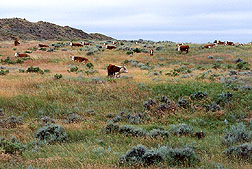Moderate Grazing Promotes Plant Diversity
|
|
Scientists researching the interdependence of plants and animals have found that a moderate level of cattle grazing makes for a more diverse ecosystem—at least on the Great Plains.
"It evens out the production of individual plant species, preventing any one from dominating," says Richard H. Hart. He is a rangeland scientist with USDA's Agricultural Research Service. His conclusions come from a grazing study at the Central Plains Experimental Range (CPER) near Nunn, Colorado.
The range is managed by the ARS Rangeland Resources Research Unit, which is headquartered at the High Plains Grassland Research Station near Cheyenne, Wyoming.
The High Plains station recently celebrated its 70th anniversary. The CPER was established in 1937 on plowed or overgrazed lands abandoned by farmers and ranchers during the Dust Bowl years. So it's no surprise that the cattle-grazing experiment may well be the longest running rangeland grazing experiment in the world. Yearling heifers have grazed the range here for 5 to 6 months each year since 1939, continuing the work of previous cattle—and the buffalo before them.
In a study comparing rangeland grazed by low to high numbers of cattle, researchers have found that plant biodiversity—as well as ranch profitability—is highest on land grazed moderately. "Moderate" is defined as one yearling heifer for every 16 acres for 5 to 6 months each year.
Plant biodiversity is highest when high numbers of plant species are combined with a more even distribution of production among species. Hart and his colleagues found 46 species of plants on the moderately grazed land, compared to 43 under heavy grazing and 36 under light grazing.
While totally ungrazed land had the same number of plant species as the moderately grazed land, its biodiversity was undercut by the dominance of prickly-pear cactus. Prickly pear contributed nearly half of the total standing crop vegetation. Moderately grazed land retained the same number of species, while reducing the prevalence of prickly pear to about 20 percent. It also reduced the dominance of blue grama and buffalograss, native prairie grasses that are encouraged by heavy grazing.
All in all, moderate grazing offers the best compromise when balancing numbers of species and their dominance with beef and forage production.
Hart says cattle weight gains decrease significantly when the land is grazed heavily, because there are not only more mouths to feed, but less forage to graze. The greater number of cattle does give the rancher more beef per acre, but the higher costs of maintaining more cattle cancels out this advantage.—By Don Comis, Agricultural Research Service Information Staff.
This research is part of Grazinglands Management, an ARS National Program described on the World Wide Web at http://www.nps.ars.usda.gov/programs/nrsas.htm.
Richard H. Hart is in the USDA-ARS Rangeland Resources Research Unit, 8408 Hildreth Rd., Cheyenne, WY 82009-8899; phone (307) 772-2433, fax (307) 637-6124.
"Moderate Grazing Promotes Plant Diversity" was published in the May 1999 issue of Agricultural Research magazine.







